Using d3.js the x coordinates of the graph are displaying at x=0 or on the y axis. The x axis represents a date and time and the y axis is the temperature. But this is only on an ipad or iphone. On my own machine, Linux, it displays correctly.
The graphs and all file can be seen at, http://shanespi.no-ip.biz
The ipad/iphone display
While the correct graph is,
Here is the javascript,
var xScale = d3.scaleTime()
.domain([new Date(datahourly[0].date), d3.max(datahourly, function(d) {return new Date(d.date)})])
.range([0, (w-2*padding)]); // max x screen space is width - twice padding
var yScale = d3.scaleLinear()
.domain([0, d3.max(datahourly, function(d) {return d.temp})])
.range([(h-2*padding), 0]); // max y screen space is height - twice padding
var xAxis = d3.svg.axis(xScale) // d3 v.4
.ticks(9) // specify the number of ticks
/*.ticks(d3.time.days, 1) */
.tickFormat(d3.time.format('%H:00'))
.scale(xScale)
.orient("bottom");
var yAxis = d3.svg.axis(yScale)
.ticks(7)
.scale(yScale)
.orient("left");
var svg = d3.select('#hourly-readings')
.append('svg') // create an <svg> element
.attr('id', 'svgDaily')
.attr('width', w) // set its dimensions
.attr('height', h);
svg.append("g")
.attr("class", "axis")
.attr("transform", "translate(" + (2*padding - 15) + "," + (padding - 15) + ")")
.call(yAxis);
svg.append('g') // create a <g> element
.attr('class', 'axis') // specify classes
.attr("transform", "translate(" + (2*padding - 15) + "," + (h - padding - 15) + ")")
.call(xAxis); // let the axis do its thing
var lineFunctionStart = d3.svg.line()
.x(function(d) {return xScale(new Date(d.date)); })
.y(h - 2*padding - 5)
.interpolate("cardinal");
var lineFunction = d3.svg.line()
.x(function(d) {return xScale(new Date(d.date)); })
.y(function(d) {return yScale(d.temp); })
.interpolate("cardinal");
svg.append("path")
.attr('d', lineFunctionStart(datahourly))
.attr('stroke', "grey")
.attr('stroke-width', 1)
.style('fill', "white")
.attr("transform","translate(" + (2*padding - 13) + "," + (padding - 10) + ")")
.transition()
.duration(3000)
.attr('d', lineFunction(datahourly));
//var svg = d3.select('svg');
var svg = d3.select('#svgDaily');
svg.append("text") // text label for the x axis
.attr("x", 310)
.attr("y", h)
.style("font-size", "12")
.style("text-anchor", "middle")
.text("Time (1 hr. intervals)");
svg.append("text") // text label for the x axis
.attr('transform', 'rotate(-90)')
.attr("x", -85) // Because rotate is first x and y coordinates are transaposed
.attr("y", padding-17)
.style("font-size","10")
.style("text-anchor", "middle")
.text("Temp. Celcius");
var rects = svg.selectAll('circle')
.data(datahourly);
var newRects = rects.enter();
newRects.append('circle')
.attr('cx', function(d, i) { return (Math.random() * (w - 2*padding)) })
//.attr('cx', function(d, i) {
//return (5 + xScale(new Date(d.date)));
//})
.attr('cy', (h - (2*padding)))
.attr('r', 5)
.style('fill', "lightblue")
.attr("transform","translate(" + (2*padding - 18) + "," + (padding - 20) + ")")
.transition()
.duration(3000)
.delay(function(d, i) {return i * 300})
.attr('cx', function(d, i) {
return (5 + xScale(new Date(d.date)));
})
.attr('cy', function(d, i) {
return 10 + yScale(d.temp);
});
Here is the 'datahourly' data,
[
{
"date":"2016-12-14 22:01:01.799830",
"temp":"24.04"
},
{
"date":"2016-12-15 00:01:02.362875",
"temp":"23.03"
},
......................
{
"date":"2016-12-15 21:01:01.868593",
"temp":"21.93"
},
{
"date":"2016-12-15 22:01:02.278817",
"temp":"15.9"
},
{
"date":"2016-12-15 23:01:01.963714",
"temp":"21.63"
}
]
I am using Chrome on Linux and Safari on the ipad and iphone. But I did install chrome on the iphone and the graph is still incorrect.
Are there svg issues with iOS?
EDIT: The main issue was that the time data was not parsed correctly,
This is the correct solution,
var data = [];
$.getJSON("data/data.json",
function(info){
data = info[0].fiveMinReadings;
//console.log(data);
var parseTime = d3.timeParse("%Y-%m-%d %H:%M:%S.%L");
data.forEach(function(d) {
d.date = d.date.slice(0,-3);// remove microseconds
d.date = parseTime(d.date);
d.temp = +d.temp;
});
// Beginning of graph for 5 minute readings
var padding = 25;
var w = 600;
var h = 300;
var xScale = d3.scaleTime()
.domain(d3.extent(data, function(d) { return d.date; }))
.range([0, (w-2*padding)]); // max x screen space is width - twice padding
var yScale = d3.scaleLinear()
.domain([0,d3.max(data, function(d) {return d.temp})])
.range([(h-2*padding), 0]); // max y screen space is height - twice padding
var xAxis = d3.axisBottom(xScale) // d3 v.4
.tickFormat(d3.timeFormat('%H:%M '))
.scale(xScale);
var yAxis = d3.axisLeft(yScale)
.scale(yScale);
var svg = d3.select('#five-min-readings')
.append('svg') // create an <svg> element
.attr('id','svgHourly')
.attr("align","center")
.attr('width', w) // set its dimensions
.attr('height', h);
var valueline = d3.line()
.curve(d3.curveCardinal)
.x(function(d) { return xScale(d.date); })
.y(h - 2*padding - 4);
var valueline2 = d3.line()
.curve(d3.curveCardinal)
.x(function(d) { return xScale(d.date); })
.y(function(d) {return yScale(d.temp); });
svg.append("text") // text label for the x axis
.attr("x", 310)
.attr("y", h)
.style("font-size", "12")
.style("text-anchor", "middle")
.text("Time (5 min. intervals)");
svg.append("text") // text label for the x axis
.attr('transform', 'rotate(-90)')
.attr("x", -85) // Because rotate is first, x and y coordinates are transaposed
.attr("y", padding-17)
.style("font-size","10")
.style("text-anchor", "middle")
.text("Temp. Celcius");
svg.append("g")
.attr("class", "axis")
.attr("transform", "translate(" + (2*padding-15) + "," + (padding-15) + ")")
.call(yAxis);
svg.append('g') // create a <g> element
.attr('class', 'axis') // specify class
.attr("transform", "translate(" + (2*padding-15) + "," + (h - padding - 15) + ")")
.call(xAxis); // let the axis do its thing
svg.append('path')
.data([data])
.attr("class","line")
.attr('d', valueline)
.attr('stroke', "grey")
.attr('stroke-width', 1)
.style('fill', "white")
.attr("transform","translate(" + (2*padding - 13) + "," + (padding -10) + ")")
.transition()
.duration(3000)
.attr('d', valueline2 );
var svg = d3.select('#svgHourly');
var rects = svg.selectAll('circle')
.data(data);
var newRects = rects.enter();
newRects.append('circle')
.attr('cx', function(d, i) { return (Math.random() * (w - 2*padding)) })
.attr('cy', h - 2*padding)
.attr('r', 5)
.attr("id", function(d,i){return "circle" + i})
.style('fill', "lightblue")
.attr("transform","translate(" + (2*padding - 18) + "," + (padding - 20) + ")")
.transition()
.duration(3000)
.delay(function(d, i) {return i * 300})
.attr('cx', function(d, i) { return (5 + xScale(d.date)); })
.attr('cy', function(d, i) { return 10 + yScale(d.temp); });
}); // closes getJSON()

